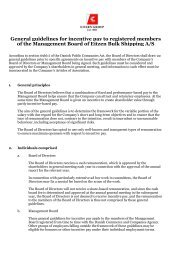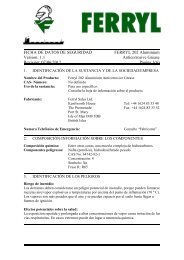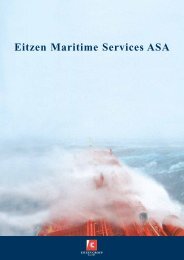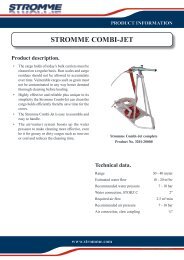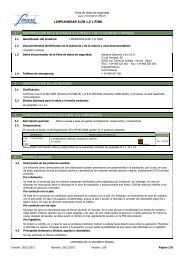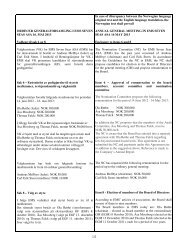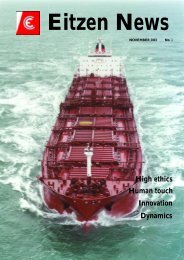Ship - target or tool?By Kaushik Roy, EMS Ship Management, EdinburghSecurity is an important issue of thiscentury. Among transport modes, shippingpresents the highest security risksince, on the one hand, it is the mainfacilitator of international trade and, onthe other hand, a terrorism-targetedship, whether a passenger or cargo carrier,poses a major threat in terms ofloss of human life and property, as wellas the threat of damage to the environment.Shipping is particularly vulnerableto terrorism, either as a direct target orindirectly as a service provider or tool.Target options in terms of numbers, e.g.major stock exchanges are multiple targetsbut still limited in number whileships are almost infinite. In terms ofsecurity, stock exchanges are well protected,whereas the ships, either at opensea or in coastal waters, are not secured.Also ships are very easy target fromhuge numbers available.In terms of geographic area impact,from a terrorist viewpoint, the larger thebetter. Thus, a successful attack on anuclear plant, assuming a radiationspread such as was the case atChernobyl, would have a regional if notnational impact while a successful attackon oil, chemical or gas tankers in themiddle of Singapore Strait or DoverStrait would have great national andinternational impact.Damage to the target and national economywould also be a consideration withrespect to a terrorist's list of possibletargets. Explosion on a cruise ship orgas carrier might seem local in geographicimpact and the economic lossrelatively small, the financial impact onthe shipping industry would be profound.A successful attack on the cruiseship would have consequences fargreater including political/psychologicalimpact than the damage to the shipitself.Casualties would rank high in targetselection. The successful attack on theWorld Trade Center and Pentagon, withcasualties in the thousands, caused anational trauma, the effects of whichwill continue for years. The same will berepeated if a large passenger ship isexploded, where thousands of peoplefrom various nations will die.The political and psychological impactof a successful terrorist attack is perhapsthe most important of all considerationsas noticed in US Navy vesselUSS Cole in 2000, leaving 17 sailorsdead and one of the most advancednaval vessels almost sunk. Terroristscould claim a major victory shouldAmericans or Britons lose faith in theirgovernment's ability to protect them.In terms of terrorist tools or weapons,shipping becomes most suitable for theillicit transport of terrorist weapons,from conventional explosives to unconventionalchemical, biological and radiologicalagents. The world has not experienceda major terrorist attack usingships or containers - at least not yet. Butit is clear that terrorists can see thepotential of using the maritime tradingsystem to conceal weapons or agents forattack purposes or to provide fundingor support for their operations.Terrorists have also used small, highspeedcraft, packed with conventionalexplosives several times in recent yearsto cause serious damage to, and deathson, much larger vessels. Large tankerscan be a major polluting threat to themarine and coastal environment. Thelarge scale of the imminent disaster havingthe corresponding publicity gainsfor the terrorists.Using flags of convenience, terroristcharteredor terrorist-owned arms carrierstransport weapon supplies to theirtheatres. These carriers are managed byterrorist front and cover companieslocated in the Western hemisphere andin the Far East. Some 90-95 per cent ofthe time, these registered carriersengage in perfectly legitimate commercialtrade. More than the lack ofstrength or expertise, it has been thelack of political courage that has impededstates from the interdiction of armsshipments for terrorist <strong>group</strong>s.Among the plethora of terrorist attacksin shipping, some of the ones that madehighlights are: the hijacking of theItalian cruise ship Achille Lauro in theMediterranean Sea, 1985; the grenadeblasting and gun firing on board theGreek cruiser City of Poros in the8 <strong>Eitzen</strong> News
Saronic Gulf, 1988; the explosion ofbuses on board the ferry Our Lady ofMediatrix in the Philippines, 2000; thebombing of the French tanker, VLCCLimberg in Yemeni waters, 2002. In allof the above incidents, each ship wastarget, not tool. Even, the ship maybecome a tool for terrorists (i.e. 9/11case). For instance, a cruise ship can bewell target, but a cargo vessel maybecome a tool for terrorism. The impactof attacking passenger ship is muchmore than a cargo vessel. The value ofhuman life is immeasurable and lots ofrich people and celebrities travel oncruise ships. Whereas, very less peopleare there on cargo ships, compared toany passenger vessel, but result of devastationmay be worse depending oncargo characteristics. Ships may be seenas political weapons by terrorists whohave political or terrorist agendas.For pirates or hijackers, ship is a hot target,not a tool for piracy. By hijacking apassenger ship or wealthy cargo ship,they can fulfil their aims. Unlike thepirates of old, many of today's piratesare maritime terrorists with an ideologicalbent and a broad political agenda.This nexus of piracy and terrorism isespecially dangerous for energy markets.Stowaways use ship as tool for humantrafficking. Normally, they have nointention to damage the ship or cargo.Their views are different as they do notuse the ship for destructive purposes,neither for any constructive purposes.A terrorist attack on transport infrastructurein a certain region will cause arise of all transport costs to that region.This will induce some people no longerto look for jobs in that region. Thelabour supply will therefore decrease inthis region. This will cause the regionsproduction to decline, and will reducerelative wage in this region. The lowerrelative wage leads to emigration out ofthat region and lowers the supply oflabour even more.Only two percent of all terrorist incidentsrecorded since 1969 have takenplace at sea. Several reasons account forthis. First, terrorists have generally preferredland venues as they are fixed, easierto penetrate and more immediatelymedia accessible. Second, operating atsea requires specialist skills andresources that all but a few organizationsposses. Third, most terrorist<strong>group</strong>s are tactically conservative, optingfor familiar methods that have beentested and offer a relatively high chanceof success.At the end, our view of what is a likelyterrorist target cannot be taken to be thesame as those of the terrorist. Overtime their objectives can be expected tochange depending upon circumstances,which in turn will change their choice oftargets; changes which cannot be accuratelyforecast. Since we cannot providemaximum security for every possibletarget, we have no choice but to identifyand prioritize targets and allocateresources accordingly.If we consider ships are likely targets,resources allocated to their security willnot change appreciably over time. Onthe other hand, a terrorist has theadvantage of flexibility in target selectionas well as flexibility in allocating thenecessary resources to attack the target.9



